They say that a dog is a man's best friend, but what happens when that friend is as powerful as a bull? Unleashing the Mighty Bullmastiff: A Guardian's Tale takes you on a journey into the world of this remarkable breed, known for their imposing size and unwavering loyalty.
But there's more to this majestic guardian than meets the eye. With their gentle and calm demeanor, Bullmastiffs have captured the hearts of many, while also proving their adaptability to apartment living.
As you navigate through the pages of this comprehensive guide, you'll uncover the secrets behind their origins, temperament, and specific care needs.
So, if you're ready to discover what it takes to be a responsible owner of a Bullmastiff, prepare yourself for an adventure like no other.
Key Takeaways
- The Bullmastiff is a breed of dog originally from England, known for being a calm, gentle, loyal, and protective guard dog.
- They have a short and dense coat, which requires low grooming needs.
- Bullmastiffs have low to moderate exercise requirements and can adapt well to apartment living, as long as they possess qualities such as being quiet, low-energy, and well-behaved.
- When considering dog ownership, it is important to prioritize factors such as aggression, barking tendencies, wanderlust potential, exercise needs, and potential for playfulness.
Bullmastiff Breed Information
The Bullmastiff, originally bred in England as a guard dog, is a powerful and loyal breed known for its calm and gentle temperament. Standing at a height of 24-27 inches for males and 22-25 inches for females, and weighing between 100-130 pounds for males and 80-100 pounds for females, the Bullmastiff is a formidable presence.
With a lifespan of 8-10 years, this breed falls under the working group category. The Bullmastiff's short and dense coat comes in various colors, including fawn, red, and brindle, requiring low grooming needs. While their exercise requirements are low to moderate, training this breed requires patience and consistency.
However, it's important to note that Bullmastiffs are prone to health issues such as hip dysplasia, elbow dysplasia, and eye problems.
Bullmastiff Adaptability and Apartment Living

After exploring the Bullmastiff's breed information, it's important to consider their adaptability to apartment living. While the Bullmastiff is a large breed, they can actually adapt well to living in an apartment. Size isn't the only factor to consider when choosing a dog for an apartment. It's essential to prioritize qualities such as being quiet, low-energy, and well-behaved.
Some small breeds may have high energy levels and excessive barking, which can be disruptive in an apartment setting. When selecting a dog for an apartment, it's also important to consider the comfort of neighbors. Creating a harmonious living environment for everyone involved is crucial.
While there are some breeds that aren't well suited to apartment living, the Bullmastiff's calm and gentle temperament makes them a suitable choice for apartment dwellers.
Behavior and Temperament Considerations
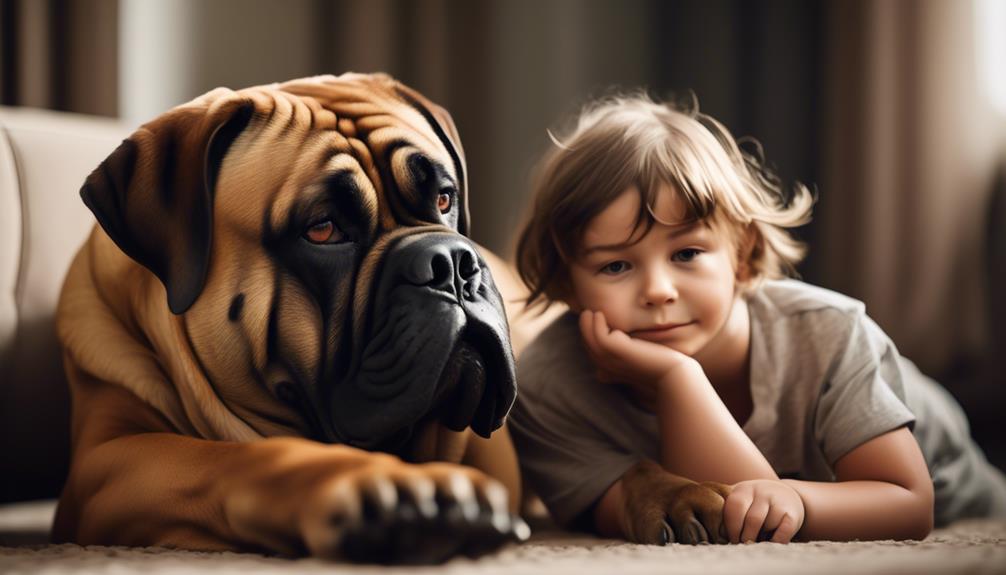
When considering the behavior and temperament of the Bullmastiff, it's important to understand their tendencies and characteristics.
Bullmastiffs are known for their calm and gentle nature, making them excellent family companions. They're fiercely loyal and protective, making them natural guardians. However, they can also be reserved with strangers, which is why early socialization is crucial.
Bullmastiffs have a tendency to bark or howl, especially when they perceive a threat. They aren't known to be wanderers, but regular exercise is still important to keep them mentally and physically stimulated. Despite their large size, Bullmastiffs can be surprisingly playful, especially with their loved ones.
Understanding these behavior and temperament considerations will help potential owners provide the right environment and training for their Bullmastiff.
Bullmastiff Breed Specific Information
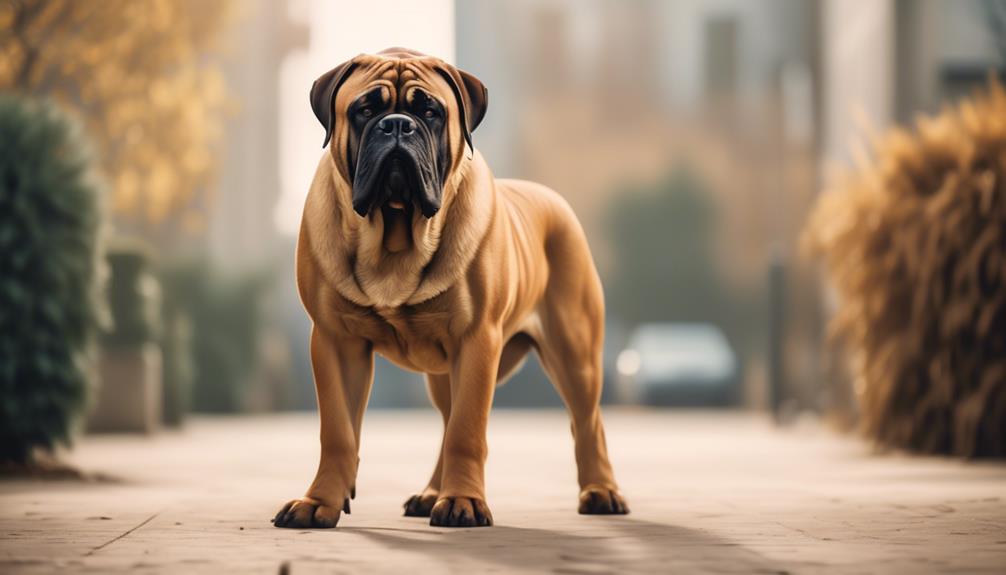
Bullmastiffs are a breed known for their impressive strength and protective instincts. When it comes to Bullmastiff breed specific information, there are several key aspects to consider:
- Origin: Bullmastiffs originated in England and were initially bred as guard dogs.
- Physical Characteristics: These dogs have a height range of 24-27 inches for males and 22-25 inches for females. They typically weigh between 100-130 pounds for males and 80-100 pounds for females. Their lifespan is around 8-10 years.
- Temperament: Bullmastiffs are known for their calm, gentle, and loyal nature. They're protective of their family and make excellent guardians.
- Coat and Grooming: Their coat is short and dense, coming in various colors such as fawn, red, and brindle. Grooming needs are low, requiring minimal maintenance.
Understanding these breed specific details can help potential owners make informed decisions when considering a Bullmastiff as a pet or companion.
General Dog Ownership Considerations

One important aspect to consider when owning a dog is their behavior and temperament. Dogs can vary greatly in these aspects, and it's crucial to choose a breed that fits well with your lifestyle and preferences.
Some dogs may have a tendency to be aggressive or fearful, while others may bark or howl excessively. It's also important to consider the wanderlust potential of a dog, as some breeds have a stronger instinct to roam than others.
Additionally, different breeds have different exercise needs and levels of playfulness. Understanding these general dog ownership considerations can help ensure a harmonious and fulfilling relationship with your canine companion.
Training and Socialization Tips
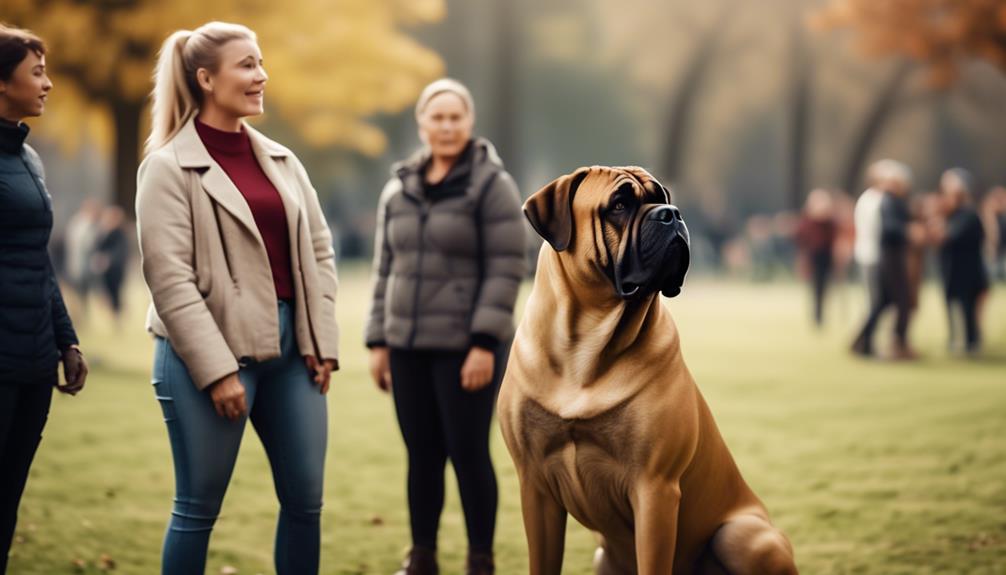
Considering the importance of behavior and temperament in dog ownership, it's essential to equip oneself with effective training and socialization tips. Here are four key tips to help train and socialize a Bullmastiff:
- Start early: Begin training and socialization as soon as possible. The earlier you start, the easier it will be to shape your dog's behavior and prevent any potential issues from developing.
- Be consistent: Consistency is crucial when training a Bullmastiff. Establish clear rules and boundaries, and ensure that everyone in the household follows them consistently. This will help your dog understand what's expected of them.
- Use positive reinforcement: Positive reinforcement is a powerful tool when training a Bullmastiff. Reward good behavior with treats, praise, and affection. This will motivate your dog to repeat the desired behavior.
- Socialize extensively: Bullmastiffs can be protective and reserved around strangers. To prevent any aggression or fear towards unfamiliar people or animals, expose your dog to various social situations from an early age. Take them to different places, introduce them to different people and animals, and provide positive experiences to help them become well-rounded and confident.
Health and Care for Bullmastiffs
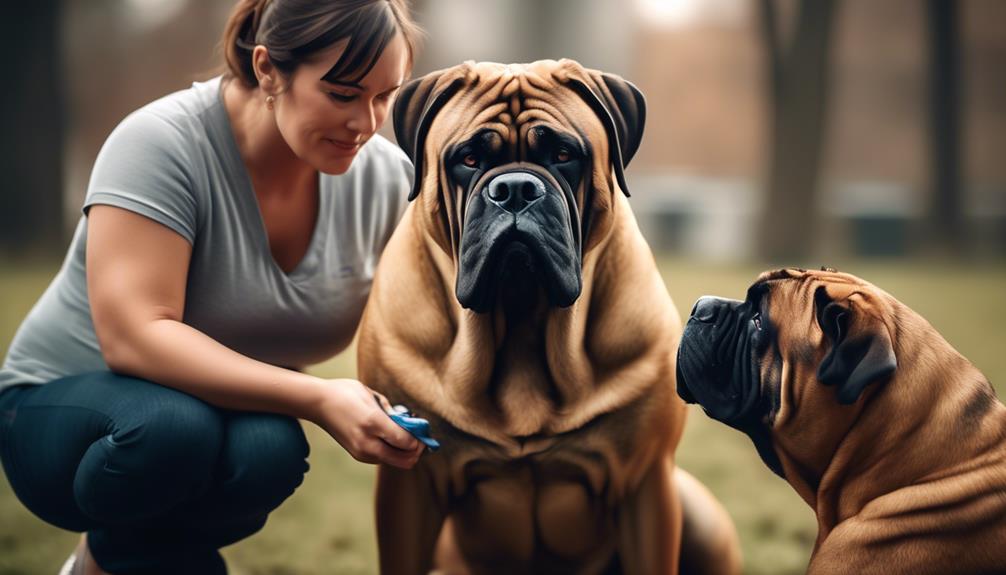
To ensure the well-being of a Bullmastiff, it's important to prioritize their health and provide proper care. Bullmastiffs are generally a healthy breed, but like any dog, they can still be prone to certain health issues.
One common problem is hip dysplasia, a condition where the hip joints don't develop properly and can lead to pain and lameness. Another issue is elbow dysplasia, which affects the elbow joints and can also cause discomfort and mobility problems. Additionally, Bullmastiffs may be prone to certain eye problems, such as entropion or ectropion, where the eyelids roll inward or outward, respectively.
Regular veterinary check-ups, a balanced diet, and appropriate exercise are essential for maintaining the health and well-being of these gentle giants.
Unleashing the Mighty Bullmastiff: A Guardian's Tale
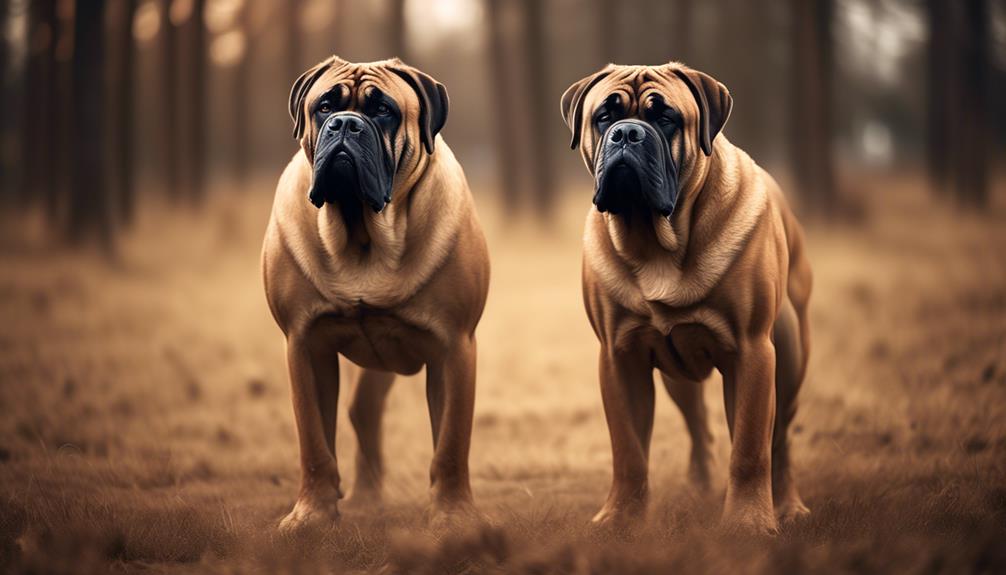
The Bullmastiff, a calm and loyal breed, unveils its might as a guardian in this captivating tale. This powerful and protective dog is known for its unwavering dedication to its family and its ability to deter intruders with its imposing presence. Here are four remarkable qualities that make the Bullmastiff an exceptional guardian:
- Strength: With its muscular build and solid frame, the Bullmastiff possesses immense strength, capable of confronting any potential threat head-on.
- Fearlessness: Fear isn't in the Bullmastiff's vocabulary. It fearlessly stands its ground, ready to defend its loved ones from any danger that may arise.
- Loyalty: The Bullmastiff's loyalty knows no bounds. It forms a deep bond with its family and will do whatever it takes to protect them, even if it means putting its own life on the line.
- Vigilance: The Bullmastiff is always on high alert, constantly scanning its surroundings for any signs of trouble. Its keen senses and attentive nature make it an excellent watchdog, ensuring the safety and security of its home.
In this tale of guardianship, the Bullmastiff's true power and unwavering devotion shine through, making it a breed worthy of admiration and respect.
Frequently Asked Questions
What Are the Exercise Requirements for a Bullmastiff?
The Bullmastiff requires low to moderate exercise. They enjoy daily walks and playtime but are not overly active. Regular exercise helps maintain their physical and mental well-being.
Are Bullmastiffs Prone to Any Specific Health Problems?
Bullmastiffs are prone to specific health problems, such as hip and elbow dysplasia, as well as eye issues. It is important for owners to be aware of these potential concerns and provide proper care to ensure their dog's well-being.
How Often Does a Bullmastiff Need to Be Groomed?
A Bullmastiff needs to be groomed regularly to maintain its short and dense coat. This breed has low grooming needs, so a weekly brushing and occasional baths should suffice to keep them looking their best.
Do Bullmastiffs Have a Tendency to Be Aggressive or Fearful?
Bullmastiffs are generally calm and gentle, but they can display aggression or fear if not properly socialized and trained. It's important for owners to provide a loving and structured environment to ensure a well-behaved and confident Bullmastiff.
Are Bullmastiffs Suitable for Families With Children?
Yes, Bullmastiffs are suitable for families with children. They are known to be calm, gentle, and protective, making them great companions for kids. However, supervision and proper socialization are important to ensure a harmonious relationship.
What are the similarities and differences between the Bullmastiff and the Boerboel in terms of their roles as guardians?
The Bullmastiff and the Boerboel share similarities as the ultimate guardian companions. Both breeds are strong, loyal, and protective, making them ideal for guarding properties and families. However, the Bullmastiff tends to be more laid-back and gentle, while the Boerboel is more assertive and territorial in its guarding role.
Conclusion
In conclusion, Unleashing the Mighty Bullmastiff: A Guardian's Tale invites readers to embark on a captivating journey into the world of this majestic breed.
With their imposing size, unwavering loyalty, and gentle demeanor, Bullmastiffs prove to be the ultimate guardians.
From apartment living to behavior considerations, this comprehensive guide equips potential owners with the knowledge needed to ensure a harmonious companionship.
So, seize the opportunity to embrace the brilliance of the Bullmastiff and revel in a remarkable relationship rooted in responsibility and respect.




